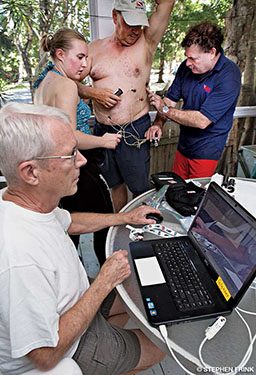In November 2016 a team of four researchers from DAN® traveled to the Florida Keys to meet with dive club members who had just arrived on vacation at a dive resort. Prior to the trip, many of the divers had consented to take part in an ongoing DAN study to record the heart rates of divers over age 40 while they were diving. This was the fourth DAN research trip to study the effects of diving on heart rhythm.
We recorded electrocardiograms (EKGs) before, during and after dives. For continuous underwater recording of EKGs we used Holter monitoring devices that we waterproofed in collaboration with a technician at the Duke Center for Hyperbaric Medicine and Environmental Physiology. Unlike the chest-strap-type heart-rate monitors, which record just the heartbeat, EKGs record electrical events that cause heartbeats and provide insight into possible causes of rhythm anomalies (dysrhythmia) if they occur.
Water, especially saltwater, changes how electrical signals travel, so the electrodes attached to the skin must be properly sealed to obtain good-quality signals. In clinical settings, EKGs are recorded while subjects rest to avoid electrical signals that originate in exercising muscles. In diving, a lot of muscle activity is involved that interferes with electrical signals from the heart. Professor James Grier of North Dakota State University developed and tested procedures for underwater recording of EKGs that minimize muscular interference.

During diving, the pressure associated with immersion and the cooling of the skin cause blood to move away from the surface and limbs and to pool in the central vessels, affecting the loading of the heart. This changes the way our hearts beat. Immersion of the face alone can lead to slowing of the heart rate via the so-called diving reflex. Despite many studies, the resulting effects of the combination of these factors are still not well understood, but there is suspicion that they increase the risk of dysrhythmia while diving, which in extreme cases may lead to deadly heart dysfunction. Our study explores the occurrence and nature of dysrhythmia while diving and possible predictive factors.
Since it is neither cost effective nor practical to send a team to recruit one or two divers at a time into this study, DAN Research sought opportunities to join dive clubs on trips in which at least 15 divers would volunteer to participate in the study. The latest trip took place in Key Largo, Fla. After the DAN Institutional Review Board approved the study, we gave interested divers participant information sheets that described the proposed research, and those who agreed to participate signed consent forms.
On the first day of the study, each participant lay down on a cot and underwent a baseline recording via a 12-lead EKG, which is the sort you would find in a hospital. Each participant wore a smaller three-lead EKG underwater during two dives, had another 12-lead EKG recording made during the dive trip on a nondiving day and then underwent one final 12-lead EKG recording at the end of the trip.
DAN researchers are now performing detailed analysis of the data as they prepare to write their first scientific paper on this study in the coming months. A few early results are apparent.
- Gearing up for the dive and entering the water increase divers’ heart rates, sometimes approaching the maximum for a diver’s age.
- Once we are underwater, our hearts slow down. The heart rate is only one indicator of heart strain, and a lower heart rate does not necessarily mean less strain on the heart muscle.
- Moving our arms around, not being streamlined and not moving slowly substantially increase divers’ heart rates and also increase interfering electrical signals from the muscles.
- At the end of the dive, the heart rate increases again while the diver exits the water.
An in-depth analysis of the EKGs will look for various rhythm anomalies, their nature and how often they occur. Meanwhile, tips for reducing stress on the heart during dive days include the following:
- Take your time gearing up, and have someone pass nonessential equipment (such as cameras) to you after you are in the water.
- Make sure you are correctly weighted; otherwise you will displace more water to become neutrally buoyant, and it will take more work to move through the water.
- Streamline your gear, and minimize unnecessary arm movements.
- Try to be horizontal when moving forward through the water; this significantly reduces the work of moving, which directly translates to workload on your heart.
- Keep an eye on your compass, and try to surface near your boat or the exit at the end of the dive to avoid long surface swims.
- When possible, leave nonessential equipment (such as cameras) topside rather than leaving them clipped to your buoyancy compensator.
- Once you’re out of the water, sit down, relax and take a minute to reflect upon your dive. This allows your heart a few moments to return to normal. DAN Research thanks all divers who have participated in this fascinating study so far.
| © Alert Diver — Q2 2017 |